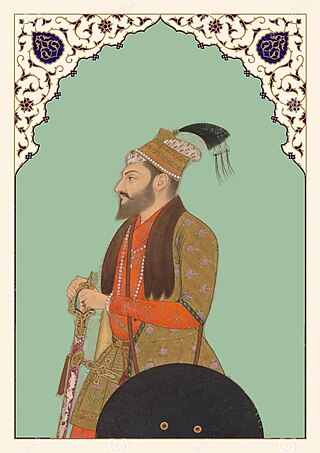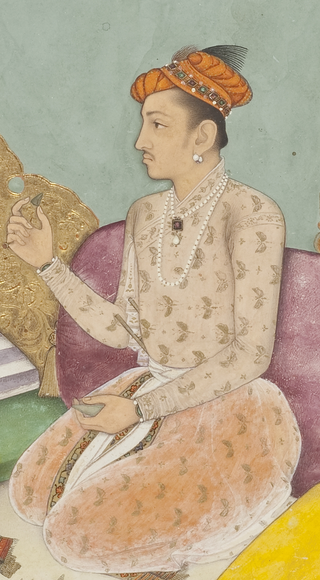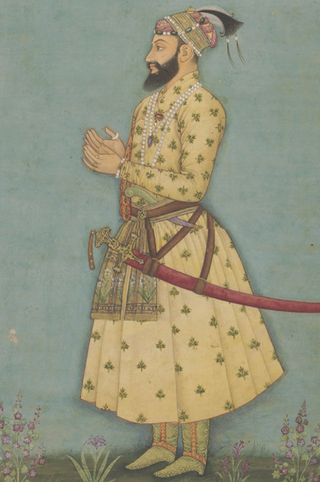
Mirza Shahab-ud-Din Muhammad Khurram, also known as Shah Jahan I, was the fifth Mughal Emperor, reigning from 1628 until 1658. During his reign, the Mughals reached the peak of their architectural and cultural achievements.

Dara Shikoh, also known as Dara Shukoh, was the eldest son and heir-apparent of the Mughal emperor Shah Jahan. Dara was designated with the title Padshahzada-i-Buzurg Martaba and was favoured as a successor by his father and his elder sister, Princess Jahanara Begum. He had been given the title of 'Shah-e-Buland Iqbal' by Shah Jahan. In the war of succession which ensued after Shah Jahan's illness in 1657, Dara was defeated by his younger brother Prince Muhiuddin. He was executed in 1659 on Aurangzeb's orders in a bitter struggle for the imperial throne.

Mirza Abu'l Fayaz Qutb-ud-Din Mohammad Azam, commonly known as Azam Shah, was briefly the seventh Mughal emperor from 14 March to 20 June 1707. He was the third son of the sixth Mughal emperor Aurangzeb and his chief consort Dilras Banu Begum.

Mirza Shah Shuja was the second son of the Mughal Emperor Shah Jahan and Empress Mumtaz Mahal. He was the governor of Bengal and Odisha and had his capital at Dhaka, in present day Bangladesh.

Mirza Muhammad Murad Bakhsh (9 October 1624 – 14 December 1661) was a Mughal prince and the youngest surviving son of Mughal Emperor Shah Jahan and Empress Mumtaz Mahal. He was the Subahdar of Balkh, till he was replaced by his elder brother Aurangzeb in the year 1647.

The Bibi Ka Maqbara is a tomb located in the city of Aurangabad in the Indian state of Maharashtra. It was commissioned in 1660 by the Mughal emperor Aurangzeb's son prince Azam Shah in the memory of his loving mother Dilras Banu Begum. It bears a striking resemblance to the Taj Mahal, the mausoleum of Aurangzeb's mother, Mumtaz Mahal and that is why it is also called the Taj of the Deccan. Aurangzeb was not much interested in architecture though he had commissioned the small, but elegant, Moti Masjid at Delhi. Bibi Ka Maqbara is the second largest structure that Aurangzeb has built, the largest being the Badshahi Mosque.

Mirza Muhammad Akbar was a Mughal prince and the fourth son of Emperor Aurangzeb and his chief consort Dilras Banu Begum. He went into exile in Safavid Persia after a failed rebellion against his father in the Deccan.

Mirza Raja Jai Singh I was the senior most general and a high ranking mansabdar at the imperial court of Mughal Empire as well as the Kachwaha ruler of the Kingdom of Amber. His predecessor was his grand uncle, Mirza Raja Bhau Singh, the younger son of Mirza Raja Man Singh I.

Dilras Banu Begum was the first wife and chief consort of Emperor Aurangzeb, the sixth Mughal emperor. She is also known by her posthumous title, Rabia-ud-Durrani. The Bibi Ka Maqbara in Aurangabad, which bears a striking resemblance to the Taj Mahal, was commissioned by her husband to act as her final resting place.

Mirza Sipihr Shikoh also known as Sipihr Shukoh, was a Mughal prince as the fourth son of Crown Prince Dara Shikoh and his consort Nadira Banu Begum.

Jahanzeb Banu Begum, popularly known as Jani Begum, was a Mughal princess and the chief consort of Muhammad Azam Shah, the heir-apparent to Emperor Aurangzeb, who briefly became Mughal emperor in 1707.
Zinat-un-Nissa Begum was a Mughal princess and the second daughter of Emperor Aurangzeb and his chief consort, Dilras Banu Begum. Her father had conferred upon her the honorable title of Padshah Begum.

Rahmat-un-Nissa, better known by her title Nawab Bai, was a secondary wife of the Mughal emperor Aurangzeb. She gave birth to Aurangzeb's first two sons, including Bahadur Shah I, who became Mughal emperor in 1707. Nawab Bai was unpopular at the Mughal court and lost her husband's favour quite early on in her life while the misconduct of her sons, Muhammad Sultan and Muhammad Muazzam, embittered her latter life. She died in 1691 in Delhi after long years of separation from her husband and children.
Aurangabadi Mahal was a consort (concubine) of the Mughal emperor Aurangzeb.

Mirza Muhammad Sultan was the eldest son of Mughal emperor Aurangzeb and his second wife Nawab Bai. His younger brother Muazzam later became Emperor as Bahadur Shah I in 1707.
Kandahari Begum was the first wife of the Mughal emperor Shah Jahan and the mother of his first child, Princess Parhez Banu Begum.
Parhez Banu Begum was a Mughal princess, the first child and eldest daughter of Mughal emperor Shah Jahan from his first wife, Qandahari Begum. She was also the older half-sister of her father's successor, the sixth Mughal emperor Aurangzeb.

The Gujarat Subah was a province (subah) of the Mughal Empire, encompassing the Gujarat region. The region first fell under Mughal control in 1573, when the Mughal emperor Akbar defeated the Gujarat Sultanate under Muzaffar Shah III. Muzaffar tried to regain the Sultanate in 1584 but failed. Gujarat remained the Mughal province governed by the viceroys and officers appointed by the Mughal emperors from Delhi. Akbar's foster brother Mirza Aziz Kokaltash was appointed as the subahdar (viceroy) who strengthened Mughal hold over the region. The nobles of former Sultanate continued to resist and rebel during the reign of the next emperor Jahangir (1605–1627) but Kokaltash and his successor subahdars subdued them. Jehangir also permitted the British East India Company to establish factories in Surat and elsewhere in Gujarat. The next emperor Shah Jahan (1627–1658) expanded his territories in south and his subahdars made hold over Kathiawar peninsula including Nawanagar. Shah Jahan had also appointed his prince Aurangzeb, who was involved in religious disputes, prince Dara Shikoh and later prince Murad Bakhsh as subahdars. Following battle of succession, Aurangzeb (1658–1707) came to the Mughal throne and his policies resulted in revolts and discontent. During his reign, the Marathas under Shivaji raided Surat (1666) and their incursions in Gujarat started. Till then Gujarat prospered due to political stability, peace and growing international trade.
The Mughal Empire's province Gujarat was managed by the Viceroys appointed by the emperors. On the death of the emperor Jahangir, his son Shah Jahan ascended to the throne in 1627. His Gujarat viceroy Sher Khán Túar worked for relief in 1630–32 famine in the province. Shah Jahan sent his men to expand its territories further south. Between 1632 and 1635, four viceroys were appointed due to their precious gift to the emperor and they could not manage the province well. Kolis of Kankrej in north Gujarat committed excesses and the Jam of Nawanagar did not paid the tribute. Soon Azam Khan was appointed who put the province in order by subduing Kolis in north and Kathis in Kathiawad. He also made the Jam of Nawanagar surrender. The next viceroy Ísa Tarkhán carried out financial reforms. In 1644, the Mughal prince Aurangzeb was appointed as the viceroy who was engaged in religious disputes for destroying a Jain temple in Ahmedabad. Due to his disputes, he was replaced by Sháistah Khán who failed to subdue Kolis. So the prince Murad Bakhsh was appointed as the viceroy in 1654. He restored the disorder soon. In 1657, hearing news of Shah Jahan's severe illness, Murad Bakhsh declared himself the emperor and rebelled with his brother Aurangzeb. They defeated the Jaswant Singh and Kásam Khán, whom Sháh Jahán had appointed viceroys of Málwa and Gujarát respectively in the battle of Dharmatpur. They further went to the capital, Agra but were confronted by Dara Shikoh. They defeated him in the Battle of Samugarh (1658). Soon Aurangzed dumped and imprisoned Murad Bakhsh, confined his father and declared himself the emperor in 1658.
The Mughal war of succession of 1658–1659 was a war of succession fought between the four sons of Shah Jahan: Aurangzeb, Dara Shikoh, Murad Bakhsh, and Shah Shuja, in hopes of gaining the Mughal Throne. Prior to the death of Shah Jahan, each of his sons held governorships during their father's reign. The emperor favoured the eldest, Dara Shikoh, However, there was resentment among the younger three, who sought at various times to strengthen alliances between themselves and against Dara. Since there was no Mughal tradition of hierarchy, the systematic passing of rule, upon an emperor's death, to his eldest son. Instead it was customary for sons to overthrow their father and for brothers to war to the death among themselves.













